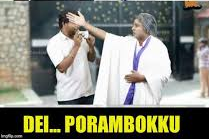“Poromboke is not yours. It’s not mine. It’s ours.”
That’s the truth hidden beneath a word most Chennaites now throw around as an insult. On the streets, “Poramboke” is hurled at people to mean worthless, useless, or even contemptible. But here’s the twist,the word never meant that at all. Somewhere along the way, a term rooted in community care was stripped of dignity and dumped into the gutter of slang.
What Poramboke Really Means
In its original Tamil, poromboke referred to shared-use community resources. Land that belonged to everyone and therefore to no one exempt from taxes. This could mean village grazing grounds, space for fairs and festivals, public meeting areas, or wetlands that supported life in countless ways. Some poromboke land was arable, some not.

From Commons to Casualties
Poromboke wasn’t private property. It was public trust. But over the decades, greed, neglect, and a dangerously casual attitude toward the commons have taken their toll.
Take Chennai’s Ennore Creek. Once a thriving estuarine ecosystem, it’s now battered by industrial encroachment. Factories, ports, and shipyards have sprawled into the wetlands. Fly ash toxic and unrelenting is dumped daily. The result? Polluted water, lost biodiversity, and fishing communities watching their livelihoods disappear with the tides.
Ennore Creek: Geography Meets Tragedy
Ennore Creek isn’t just a stagnant pool. It’s a living link in a network of water systems. Sitting along the Coromandel Coast, it connects to the Pulicat lagoon and the Buckingham Canal. It breathes with the tides, drawing in seawater during high tide and letting it flow back. Or it did, before human intervention began choking its arteries.

The North Chennai Thermal Power Station looms at one end, the Ennore Thermal Power Station at the other. Between them, siltation from the Ennore Port creeps in, quietly turning deep channels into shallow traps. What was once a natural flood buffer is now a blocked, burdened waterway.
The Song That Shouted Back
In 2016, a group of YouTubers decided to fight the apathy with art. Chennai Poromboke Paadal began as an essay by journalist-activist Nityanand Jayaram. Kaber Vasuki shaped it into lyrics. Then Temple Monkey, known for satirical, character-driven skits, brought it to life on video.
It wasn’t angry shouting. It was sly, sharp, and painfully funny. Characters in everyday office wear, shots drenched in blue evoking water and memory and the haunting reminder of the 2015 floods that submerged Chennai. Beneath the humor, the question lingered: What are we doing to what’s ours?
When Carnatic Took a Stand
Then came 2017. T. M. Krishna, the maverick of Carnatic music, lent his voice to the same lyrics. With violin, mridangam, and kanjira weaving around his powerful delivery, the song turned from clever satire into an almost spiritual call to arms.
When I first heard it, I couldn’t even catch the words. The melody carried me first; the message sank in later. And by the time Krishna reached the crescendo, staking a claim to the commons in ragam and rhythm, it was impossible to ignore. This wasn’t just music. It was protest.
Claiming What’s Ours, Together
Poromboke isn’t a curse. It’s a promise, that some things are beyond ownership, meant to be cared for by all. The tragedy is that we forgot. The hope is that we can remember.
Ennore Creek, and every other commons we’ve neglected, can heal if we choose to act. Keep them clean. Protect them from greed. Pass them on better than we found them.
Because next time someone shouts, “Dei Poramboke!” maybe, just maybe, we’ll hear it as a reminder, not an insult.
For Part 1, Part 2, Part 3, Part 4
Follow my Youtube channel
Subscribe to our email newsletter to get the latest posts delivered right to your email.

Nice explanation Janaki. Learnt new information about Ennore